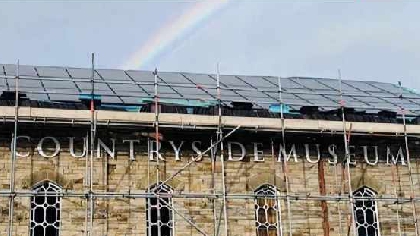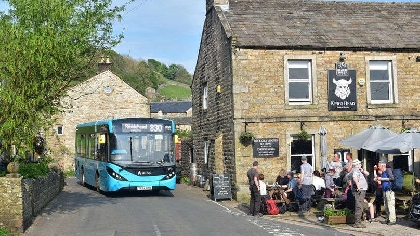
Engineers are installing solar panels, air source heat pumps and LED lighting in Yorkshire Dales National Park Authority buildings, while electric vehicle charging points have gone in at all ten of the Authority’s public car parks.
The renewable energy installations will result in a 40% reduction in the annual amount of carbon dioxide emitted from running the Authority’s properties.
Aysgarth Falls National Park Centre (NPC), Malham NPC and the Dales Countryside Museum in Hawes have had solar panels installed in the past few weeks. Solar panels will soon also go on the roof at the Colvend offices in Grassington, while additional panels have been put on the roof of the Authority’s other offices, Yoredale in Bainbridge. Air source heat pumps will be installed at Malham and Aysgarth Falls NPCs next week. Each property where work is being done is expected to generate electricity for the National Grid outside of business hours or during long sunny spells. Lighting has been changed to LED in all Authority buildings. The work is being part funded by a grant from the Public Sector Decarbonisation scheme.
Separately, seven new electric vehicle chargers have been installed in the Authority’s car parks this year, to add to the three installed last year. Help from Craven District Council and a grant from the On-street Residential Chargepoint Scheme made the installations possible. Each unit is a Podpoint 7kw dual charger, dispensing energy costing 25 pence per kilowatt hour (kWh). Charging a car for one hour at one of the new points adds about 30 miles of range.
Member Champion for Sustainable Development, Carl Lis, said: “The climate and nature emergency demands the sort of rapid response that we are making. By March last year, the National Park Authority had reduced its own carbon dioxide emissions by 64% compared with 2005. The latest work will reduce our emissions further. But we know we still have a long way to go.
“We want to eliminate carbon dioxide emissions from our operations, as well as embed sustainability in everything we do and use, from the materials we use for fixing paths or planting trees to the jackets we wear while out working. We can take encouragement from the progress being made but we must not let up.”
The first three electric vehicle chargers in National Park Authority car parks, installed last year, have saved nearly 4,000 tonnes of carbon dioxide being emitted.
Mr Lis added: “We looked at the benefits from the first three EV charge points and decided to put in a further seven of them. We know that our charging points cost people a bit more than a typical charging point at home. The idea, though, is for drivers to top up at these points, rather than rely on them to fully charge. We hope the charging points will give electric vehicle users confidence to visit the National Park and be sure that they can ‘fill up’ if necessary. We plan to review regularly the usage of the existing chargers and may install more at specific sites as demand increases.”
The Yorkshire Dales National Park Authority started a programme of actively reducing its carbon emissions in 2006. By March 2019, it had reduced emissions by 64% compared with 2005.
The Authority’s Carbon Reduction Plan – approved at a full Authority meeting in April 2020 – sets it on a course to reduce carbon dioxide emissions from operations by at least 95% by 2030 compared with the 2005 baseline.


 Council chiefs agree record £2.5m investment in car parks
Council chiefs agree record £2.5m investment in car parks
 Summer bus services in the Dales extended
Summer bus services in the Dales extended
 Dales pub landlady loses enforcement notice appeal
Dales pub landlady loses enforcement notice appeal
 Ex-National Park head and son pay tribute to Pennine Way in song
Ex-National Park head and son pay tribute to Pennine Way in song
 A PRESSING engagement at Gallery on the Green
A PRESSING engagement at Gallery on the Green
 Dales pavilion featured in TV advert becomes thriving hub
Dales pavilion featured in TV advert becomes thriving hub
 Planners refuse Richmond housing development
Planners refuse Richmond housing development
 Wider ban on heather burning ‘risks catastrophic wildfires’
Wider ban on heather burning ‘risks catastrophic wildfires’
Comments
Add a comment